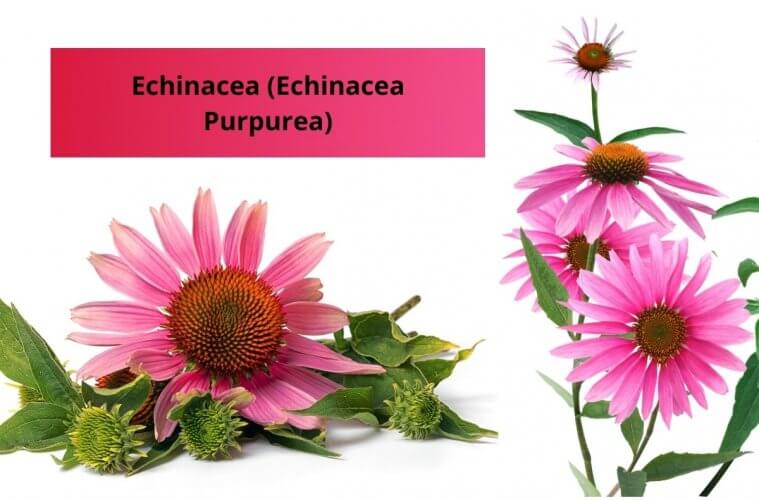Echinacea is a plant with a long history of use as herbal medicine. It has been used for more than 150 years to treat colds, flu, coughs, sore throats, bronchitis, and other respiratory tract infections. Echinacea has also been studied extensively in a laboratory for its effects on the immune system. Echinacea’s immunostimulant properties may account for many of its traditional uses and some modern medicinal applications.
Contents
Common Names
The plant’s common names are eastern purple coneflower, purple coneflower, hedgehog coneflower, echinacea, Black Sampson, Comb Flower, Coneflower, Indian Head Missouri Snakeroot, Red Sunflower.

Habitat
Echinacea purpurea is native to the moist prairies and savanna areas of Eastern North America.
But its habitat varies by region. For example, it has been observed on the coastal sand dunes of Florida and Nevada’s dry Mojave Desert.
Description
Echinacea’s flower has five petals, ranging from light to dark purple colors with white streaks on them. The flowers grow atop long stems called inflorescences, or “heads.” Echinacea often looks like it has pinkish-purple pom-poms at the end of its head!
Echinacea’s leaves are gray-green on top and yellow underneath. They can be up to 12-inches across, according to some reports! In addition, these plants have knobby roots (rhizomes) that produce more shoots when cut off their mother plant.
Part Used
The flowers, leaves, stems, and roots of the echinacea are used for medicinal treatments.

Traditional Uses and Benefits
Echinacea has been used for hundreds of years to relieve colds. The plant has a long history as the subject of various research studies conducted by universities worldwide.
Eating Echinacea roots or drinking tea made from its flowers can help reduce symptoms like nasal congestion, sore throat pain, and fever associated with upper respiratory infections due to their immune system-enhancing properties.
This medicinal herb stimulates the production of white blood cells, which assist in protecting your body against infection, diseases, and viruses. It helps to increase natural immune defenses by stimulating other parts of our immune system like lymphocytes, phagocytic leukocytes, and macrophages.
Echinacea extract may lower blood sugar levels and improve glucose tolerance. And also it can reduce the total glycemic index of a meal by as much as 22%.
Echinacea has decreased inflammation in the throat, lungs, or urinary tract. It also may cure skin conditions such as boils, ulcers, sores from burns or frostbite, ringworm infections on the scalp (tinea capitis), and toothaches caused by infection with gonorrhea.
Echinacea is often used to shorten the duration, severity, and occurrence frequency of upper respiratory infections such as influenza or common colds. It boosts the body’s natural defenses against bacteria that can cause illness.
Echinacea has been studied to reduce feelings of anxiety.
Native Americans have been using this medicinal plant for centuries as a natural remedy due to its ability to protect the body against infection.
Echinacea can be used to treat skin infections like eczema and dermatitis.
The plant extract has been found to inhibit the proliferation of human cancer cells. It may also have a role in reducing inflammation that leads to tumor growth and metastasis and inhibiting angiogenesis, which supplies oxygenated blood vessels for tumors.
Echinacea can be taken by mouth or applied topically to treat burns, cuts, ulcers, or bedsores. It can promote healing by regulating white blood cell formation so that it doesn’t accumulate at damaged tissue sites and cause further damage.

Dosage and Precautions
The recommended dosage of echinacea is up to 10-15 ml three times daily, or dry powdered extract doses three times at 300-500 mg per dose.
Echinacea should not be given to children under four years old unless their physician approves it.
It should not be used for more than three weeks. Longer-term use may cause liver problems like jaundice if you have hepatitis C, so consult with your doctor before starting treatment long term.
Echinacea has no known interactions when combined with any medication except immune suppressants.
References
- Ear, Nose, and Throat. https://earnosethroat.blogspot.com/
- Echinacea: Benefits, Uses, Side Effects, and Dosage. https://www.healthline.com/nutrition/echinacea
- https://en.wikipedia.org/wiki/Echinacea_purpurea
https://www.homeremediesweb.com/nasal_congestion_home_remedy.php
- Echinacea remedy not for children under 12, says MHRA – BBC. https://www.bbc.com/news/health-19318309
DISCLAIMER
The content and information on newerapost for information and educational purposes only. It is not for self-diagnosis and self-treatment. The content is not a medical manual. Before beginning the use of any prescription, medication and pursuing any self-treatment, all readers should consult a physician.
The information given in this article is intended to help you make informed decisions for your health. You must consult with your doctor before pursuing any natural remedies if you are under care for any health condition.
Do not take any vitamins, minerals, herbs, or other supplements without consulting your doctor, if you are taking any medication. The website does not make a representation, express or implied, regarding the accuracy of the information and does not accept any single responsibility for any errors or misuse.

